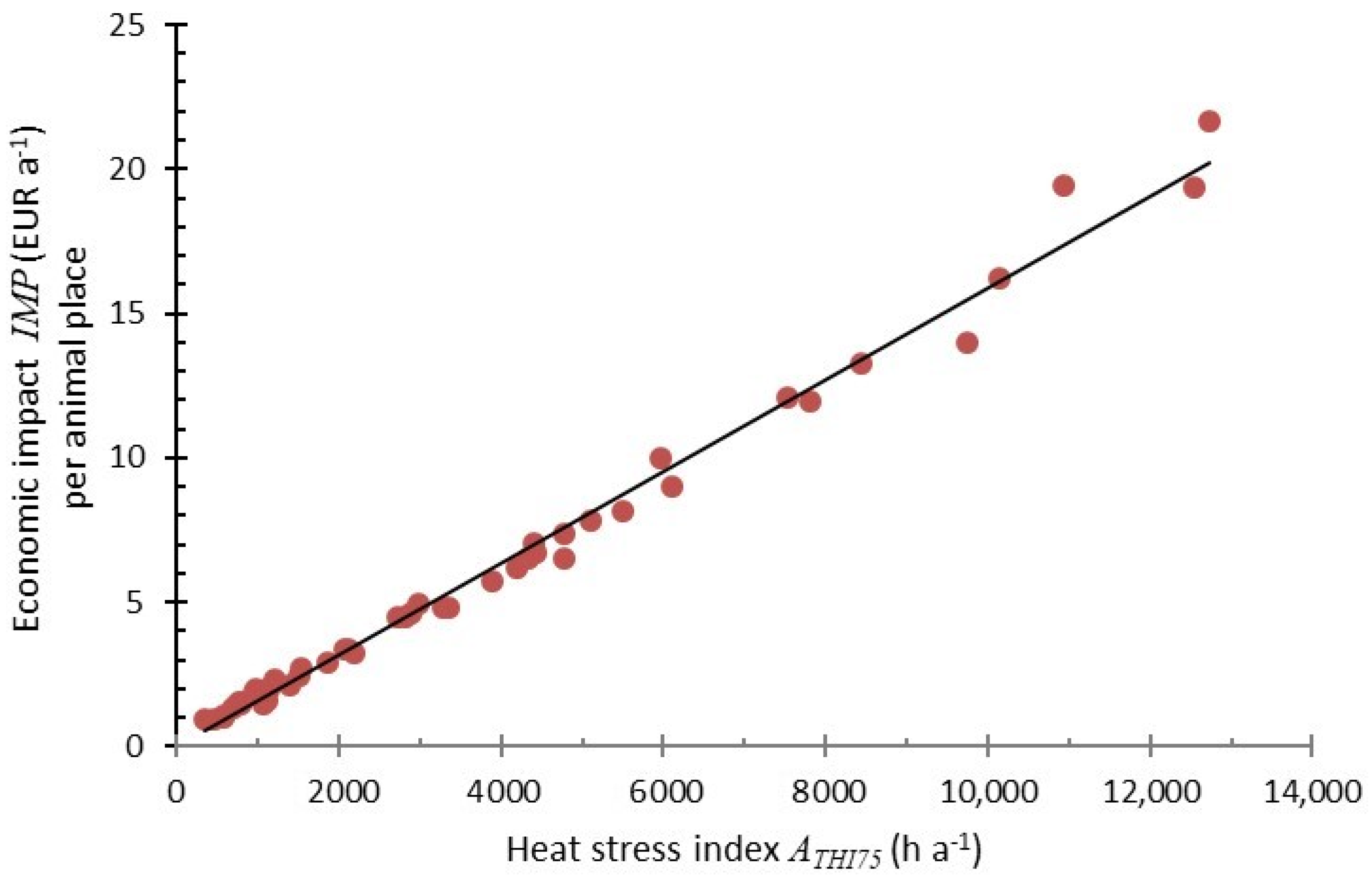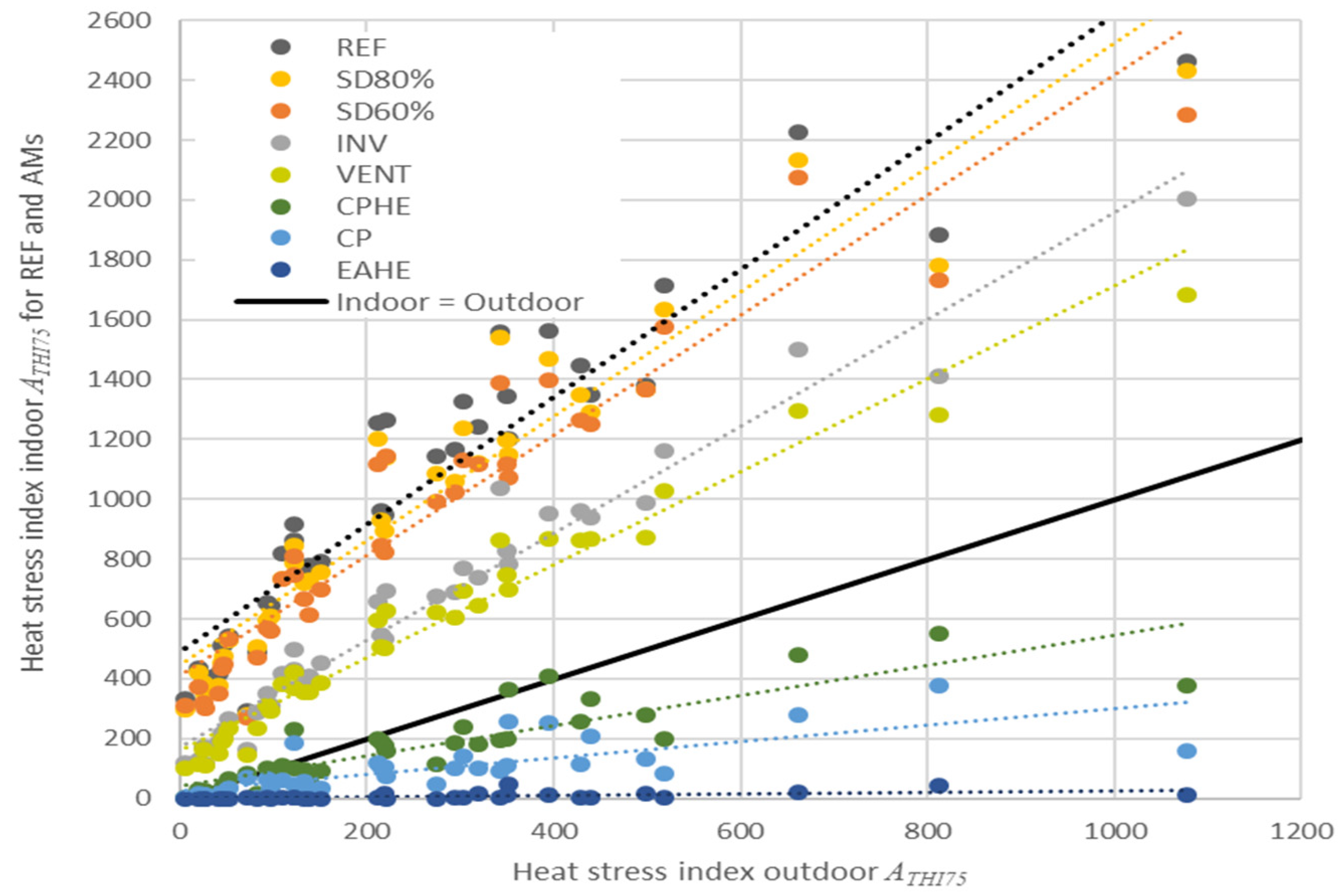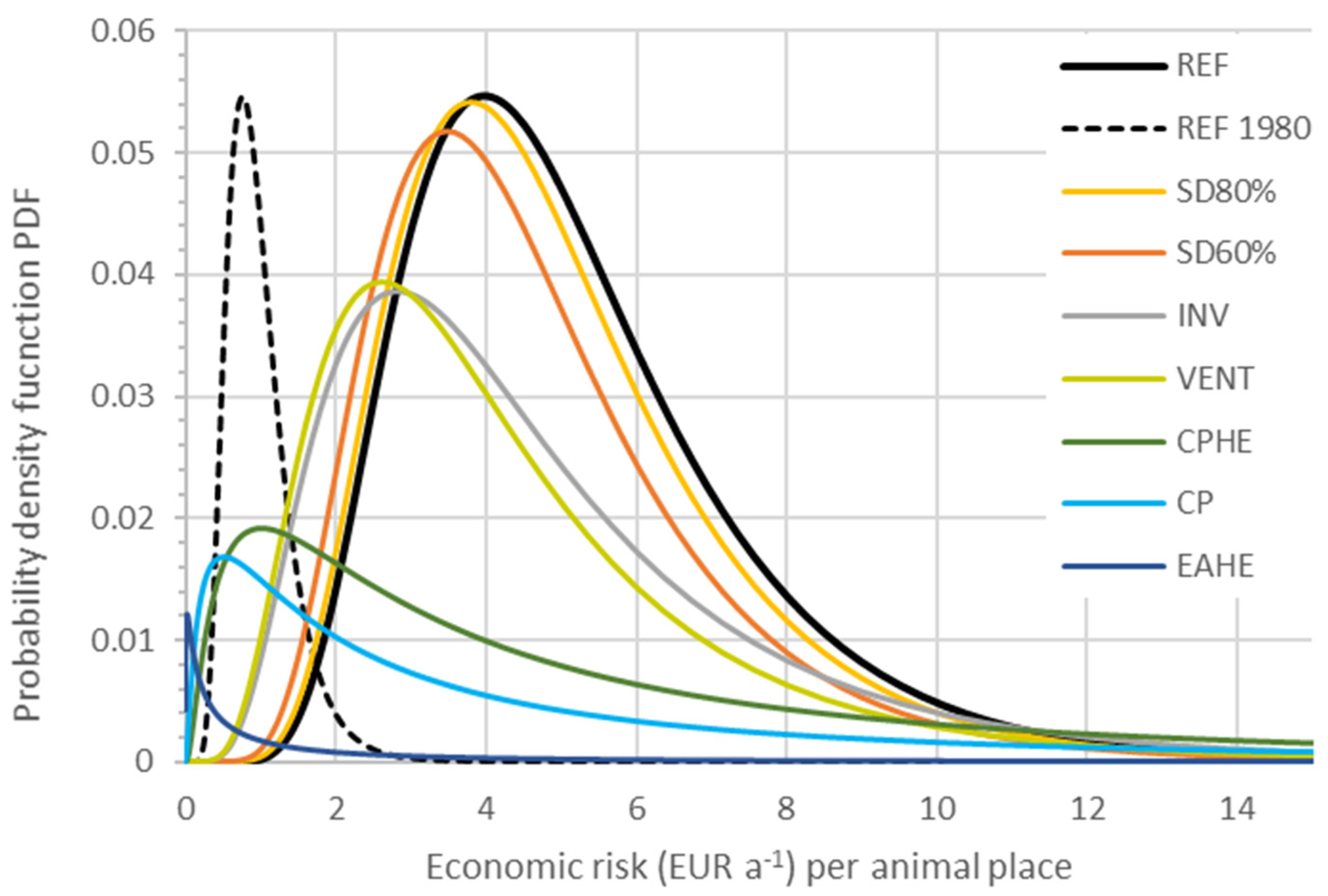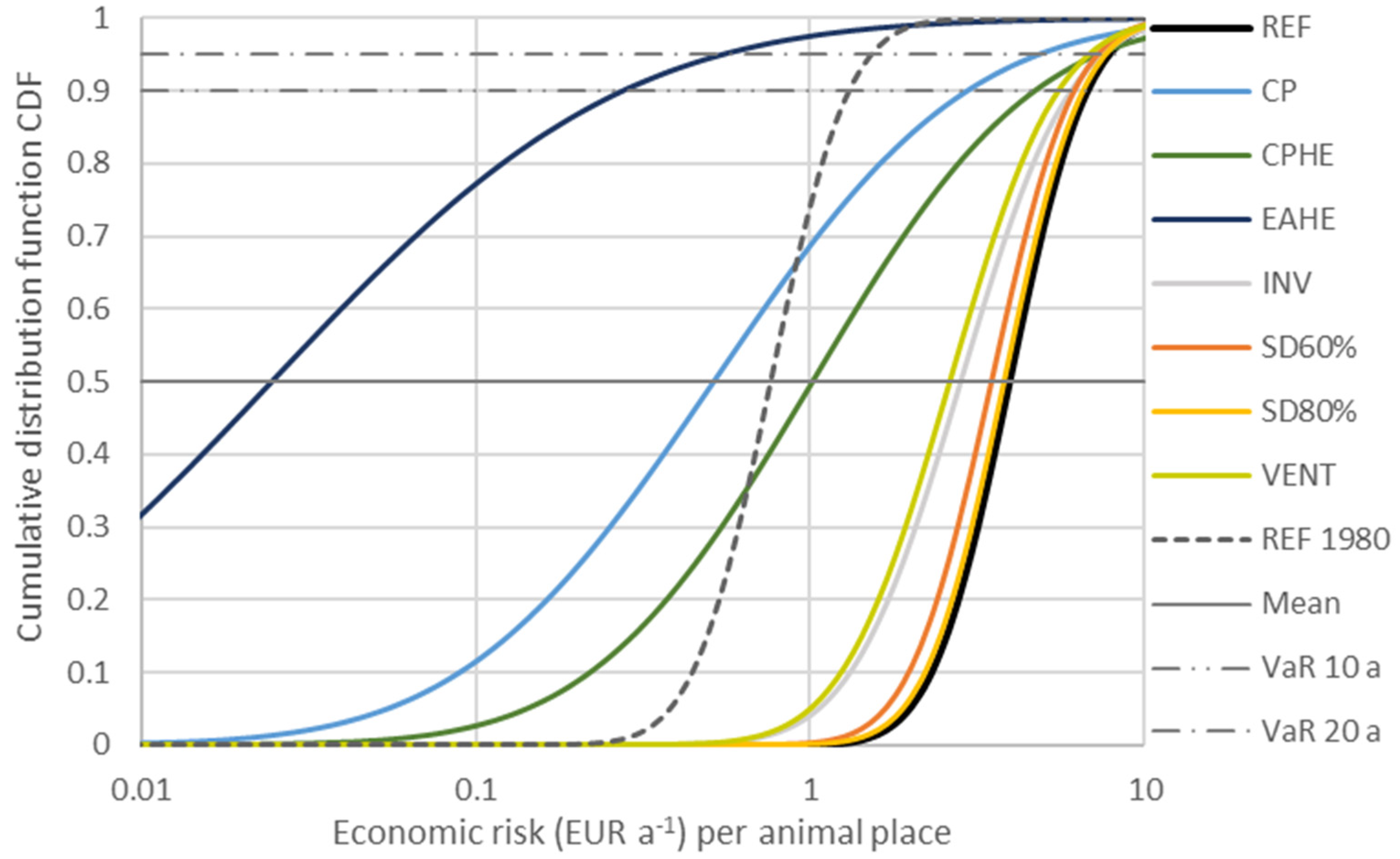Reduction of the Economic Risk by Adaptation Measures to Alleviate Heat Stress in Confined Buildings for Growing-Fattening Pigs Modelled by a Projection for Central Europe in 2030
Abstract
:1. Introduction
2. Materials and Methods
2.1. Simulation of the Thermal Climate inside Livestock Buildings
2.2. Quantification of Heat Stress
2.3. Modification of HS inside Pig Buildings by the Use of Adaptation Measures
2.4. Economic Impact of HS
3. Results
3.1. HS of the Reference Livestock Building (REF) and the Reduction of HS by the Application of AMs
3.2. Consequence of Global Warming on the Likelihood of Heat Stress
3.3. Economic Risk for Pig Farms Due to Global Warming
4. Discussion
5. Conclusions
Author Contributions
Funding
Institutional Review Board Statement
Informed Consent Statement
Data Availability Statement
Acknowledgments
Conflicts of Interest
References
- Murray-Tortarolo, G.N.; Jaramillo, V.J. The Impact of Extreme Weather Events on Livestock Populations: The Case of the 2011 Drought in Mexico. Clim. Chang. 2019, 153, 79–89. [Google Scholar] [CrossRef]
- COPA-COGECA. Assessment of the Impact of the Heat Wave and Drought of the Summer 2003 on Agricultural and Forestry; Comitêdês Organisations Professionalles de la Agricoles de la Communité Européenne/Comitê General de la Cooperation Agricole: Köln, Germany, 2004. [Google Scholar]
- Nardone, A.; Ronchi, B.; Lacetera, N.; Ranieri, M.; Bernabucci, U. Effects of Climate Changes on Animal Production and Sustainability of Livestock Systems. Livest. Sci. 2010, 130, 57–69. [Google Scholar] [CrossRef]
- Özkan, Ş.; Vitali, A.; Lacetera, N.; Amon, B.; Bannink, A.; Bartley, D.J.; Blanco-Penedo, I.; de Haas, Y.; Dufrasne, I.; Elliott, J.; et al. Challenges and Priorities for Modelling Livestock Health and Pathogens in the Context of Climate Change. Environ. Res. 2016, 151, 130–144. [Google Scholar] [CrossRef]
- Bett, B.; Kiunga, P.; Gachohi, J.; Sindato, C.; Mbotha, D.; Robinson, T.; Lindahl, J.; Grace, D. Effects of Climate Change on the Occurrence and Distribution of Livestock Diseases. Prev. Veter.-Med. 2017, 137, 119–129. [Google Scholar] [CrossRef]
- Morgan, E.R.; Wall, R. Climate Change and Parasitic Disease: Farmer Mitigation? Trends Parasitol. 2009, 25, 308–313. [Google Scholar] [CrossRef]
- Wall, R.; Rose, H.; Ellse, L.; Morgan, E. Livestock Ectoparasites: Integrated Management in a Changing Climate. Veter.-Parasitol. 2011, 180, 82–89. [Google Scholar] [CrossRef] [PubMed]
- van Dijk, J.; Sargison, N.; Kenyon, F.; Skuce, P. Climate Change and Infectious Disease: Helminthological Challenges to Farmed Ruminants in Temperate Regions. Animal 2010, 4, 377–392. [Google Scholar] [CrossRef] [Green Version]
- Skuce, P.; Morgan, E.; van Dijk, J.; Mitchell, M. Animal Health Aspects of Adaptation to Climate Change: Beating the Heat and Parasites in a Warming Europe. Animal 2013, 7, 333–345. [Google Scholar] [CrossRef] [PubMed] [Green Version]
- Hatfield, J.L.; Antle, J.; Garrett, K.A.; Izaurralde, R.C.; Mader, T.; Marshall, E.; Nearing, M.; Robertson, G.P.; Ziska, L. Indicators of Climate Change in Agricultural Systems. Clim. Chang. 2020, 163, 1719–1732. [Google Scholar] [CrossRef] [Green Version]
- Gerber, P.; Steinfeld, H.; Henderson, B.; Mottel, A.; Opio, C.; Dijkman, J.; Falcucce, A.; Tempio, G. Tackling Climate Change Through Livestock; Food and Agriculture Organization of the United Nations (FAO): Rome, Italy, 2013. [Google Scholar]
- Robinson, T.; Thornton, P.; Franceschini, G.; Kruska, R.; Chiozza, F.; Notenbaert, A.; Cecchi, G.; Herrero, M.; Epprecht, M.; Fritz, S. Global Livestock Production Systems; Food and Agriculture Organization of the United Nations (FAO): Rome, Italy, 2011. [Google Scholar]
- Niamir-Fuller, M. Towards Sustainability in the Extensive and Intensive Livestock Sectors. Rev. Sci. Tech. de l’OIE 2016, 35, 371–387. [Google Scholar] [CrossRef]
- Mikovits, C.; Zollitsch, W.; Hörtenhuber, S.; Baumgartner, J.; Niebuhr, K.; Piringer, M.; Anders, I.; Andre, K.; Hennig-Pauka, I.; Schönhart, M.; et al. Impacts of Global Warming on Confined Livestock Systems for Growing-Fattening Pigs: Simulation of Heat Stress for 1981 to 2017 in Central Europe. Int. J. Biometeorol. 2019, 63, 221–230. [Google Scholar] [CrossRef] [PubMed] [Green Version]
- Schauberger, G.; Schönhart, M.; Zollitsch, W.; Hörtenhuber, S.; Kirner, L.; Mikovits, C.; Baumgartner, J.; Piringer, M.; Knauder, W.; Anders, I.; et al. Economic Risk Assessment by Weather-Related Heat Stress Indices for Confined Livestock Buildings: A Case Study for Fattening Pigs in Central Europe. Agriculture 2021, 11, 122. [Google Scholar] [CrossRef]
- Fouad, A.M.; Chen, W.; Ruan, D.; Wang, S.; Xia, W.; Zheng, C. Impact of Heat Stress on Meat, Egg Quality, Immunity and Fertility in Poultry and Nutritional Factors That Overcome These Effects: A Review. Int. J. Poult. Sci. 2016, 15, 81–95. [Google Scholar] [CrossRef] [Green Version]
- St-Pierre, N.; Cobanov, B.; Schnitkey, G. Economic Losses from Heat Stress by US Livestock Industries. J. Dairy Sci. 2003, 86, E52–E77. [Google Scholar] [CrossRef] [Green Version]
- Dittrich, R.; Wreford, A.; Topp, C.; Eory, V.; Moran, D. A Guide towards Climate Change Adaptation in the Livestock Sector: Adaptation Options and the Role of Robust Decision-Making Tools for Their Economic Appraisal. Reg. Environ. Chang. 2017, 17, 1701–1712. [Google Scholar] [CrossRef] [Green Version]
- Renaudeau, D.; Collin, A.; Yahav, S.; de Basilio, V.; Gourdine, J.-L.; Collier, R. Adaptation to Hot Climate and Strategies to Alleviate Heat Stress in Livestock Production. Animal 2012, 6, 707–728. [Google Scholar] [CrossRef] [PubMed] [Green Version]
- Schauberger, G.; Hennig-Pauka, I.; Zollitsch, W.; Hörtenhuber, S.J.; Baumgartner, J.; Niebuhr, K.; Piringer, M.; Knauder, W.; Anders, I.; Andre, K.; et al. Efficacy of Adaptation Measures to Alleviate Heat Stress in Confined Livestock Buildings in Temperate Climate Zones. Biosyst. Eng. 2020, 200, 157–175. [Google Scholar] [CrossRef]
- Schauberger, G.; Mikovits, C.; Zollitsch, W.; Hörtenhuber, S.; Baumgartner, J.; Niebuhr, K.; Piringer, M.; Knauder, W.; Anders, I.; Andre, K.; et al. Global Warming Impact on Confined Livestock in Buildings: Efficacy of Adaptation Measures to Reduce Heat Stress for Growing-Fattening Pigs. Clim. Chang. 2019, 156, 567–587. [Google Scholar] [CrossRef] [Green Version]
- Vitt, R.; Weber, L.; Zollitsch, W.; Hörtenhuber, S.; Baumgartner, J.; Niebuhr, K.; Piringer, M.; Anders, I.; Andre, K.; Hennig-Pauka, I.; et al. Modelled Performance of Energy Saving Air Treatment Devices to Mitigate Heat Stress for Confined Livestock Buildings in Central Europe. Biosyst. Eng. 2017, 164, 85–97. [Google Scholar] [CrossRef]
- Prettenthaler, F.; Köberl, J.; Bird, D.N. ‘Weather Value at Risk’: A Uniform Approach to Describe and Compare Sectoral Income Risks from Climate Change. Sci. Total. Environ. 2016, 543, 1010–1018. [Google Scholar] [CrossRef] [PubMed]
- Toeglhofer, C.; Mestel, R.; Prettenthaler, F. Weather Value at Risk: On the Measurement of Noncatastrophic Weather Risk. Weather. Clim. Soc. 2012, 4, 190–199. [Google Scholar] [CrossRef]
- Schauberger, G.; Piringer, M.; Petz, E. Steady-State Balance Model to Calculate the Indoor Climate of Livestock Buildings, Demonstrated for Finishing Pigs. Int. J. Biometeorol. 2000, 43, 154–162. [Google Scholar] [CrossRef]
- Schauberger, G.; Piringer, M.; Petz, E. Diurnal and Annual Variation of Odour Emission from Animal Houses: A Model Calculation for Fattening Pigs. J. Agric. Eng. Res. 1999, 74, 251–259. [Google Scholar] [CrossRef]
- Schönwiese, C.-D. Praktische Statistik für Meteorologen und Geowissenschaftler, 5th ed.; Gebrüder Borntraeger: Stuttgart, Germany, 2013. [Google Scholar]
- Beniston, M.; Stoffel, M.; Guillet, S. Comparing Observed and Hypothetical Climates as a Means of Communicating to the Public and Policymakers: The Case of European Heatwaves. Environ. Sci. Policy 2017, 67, 27–34. [Google Scholar] [CrossRef]
- Orth, R.; Zscheischler, J.; Seneviratne, S. Record Dry Summer in 2015 Challenges Precipitation Projections in Central Europe. Sci. Rep. 2016, 6, 28334. [Google Scholar] [CrossRef] [PubMed]
- Anders, I.; Stagl, J.; Auer, I.; Pavlik, D. Climate Change in Central and Eastern Europe. In Managing Protected Areas in Central and Eastern Europe Under Climate Change; Rannow, S., Neubert, M., Eds.; Springer: Cham, The Netherlands, 2014; pp. 17–30. [Google Scholar]
- Beniston, M.; Stephenson, D.B.; Christensen, O.B.; Ferro, C.A.T.; Frei, C.; Goyette, S.; Halsnæs, K.; Holt, T.; Jylhä, K.; Koffi, B.; et al. Future Extreme Events in European Climate: An Exploration of Regional Climate Model Projections. Clim. Chang. 2007, 81, 71–95. [Google Scholar] [CrossRef] [Green Version]
- Della-Marta, P.M.; Beniston, M. Summer Heat Waves in Western Europe, Their Past Change and Future Projections. In Climate Variability and Extremes during the Past 100 Years; Springer: Singapore, 2008; pp. 235–250. [Google Scholar]
- Della-Marta, P.M.; Haylock, M.R.; Luterbacher, J.; Wanner, H. Doubled Length of Western European Summer Heat Waves Since 1880. J. Geophys. Res. Earth Surf. 2007, 112, 11. [Google Scholar] [CrossRef] [Green Version]
- Hendry, D.F.; Pretis, F. All Change! The Implications of Non-Stationarity for Empirical Modelling, Forecasting and Policy; Oxford Martin School Policy Paper Series: Oxford, UK, 2016. [Google Scholar]
- Sulikowska, A.; Wypych, A. Seasonal Variability of Trends in Regional Hot and Warm Temperature Extremes in Europe. Atmosphere 2021, 12, 612. [Google Scholar] [CrossRef]
- Sutton, R.T. ESD Ideas: A Simple Proposal to Improve the Contribution of IPCC WGI to the Assessment and Communication of Climate Change Risks. Earth Syst. Dyn. 2018, 9, 1155–1158. [Google Scholar] [CrossRef] [Green Version]
- KTBL. Faustzahlen für die Landwirtschaft, 15th ed.; Kuratorium für Technik und Bauwesen in der Landwirtschaft, KTBL: Darmstadt, Germany, 2018; p. 1384. [Google Scholar]
- Hoste, R. International Comparison of Pig Production Costs 2015: Results of InterPIG.; Wageningen Economic Research: Wageningen, The Netherlands, 2017. [Google Scholar]
- BPEX. 2012 Pig Cost of Production in Selected Countries; British Pig Executive, Agriculture and Horticulture Development Board, AHDB Market Intelligence: Kenilworth, UK, 2013. [Google Scholar]
- Edwards, W. Computing a Livestock Building Cash Rental Rate; Iowa State University: Ames, IA, USA, 2015. [Google Scholar]
- Rojo-Gimeno, C.; Postma, M.; Dewulf, J.; Hogeveen, H.; Lauwers, L.; Wauters, E. Farm-Economic Analysis of Reducing Antimicrobial Use whilst Adopting Improved Management Strategies on Farrow-to-Finish Pig Farms. Prev. Veter.-Med. 2016, 129, 74–87. [Google Scholar] [CrossRef] [PubMed]
- Mitter, H.; Schönhart, M.; Larcher, M.; Schmid, E. The Stimuli-Actions-Effects-Responses (SAER)-framework for Exploring Perceived Relationships between Private and Public Climate Change Adaptation in Agriculture. J. Environ. Manag. 2018, 209, 286–300. [Google Scholar] [CrossRef]
- North, M.A.; Ouweneel, B. Global Risk of Heat Stress to Cattle under Climate Change. agriRxiv 2020, 37. [Google Scholar] [CrossRef]
- Xiong, Y.; Yi, H.; Wu, Q.; Jiang, Z.; Wang, L. Effects of Acute Heat Stress on Intestinal Microbiota in Grow-Finishing Pigs, and Associations with Feed Intake and Serum Profile. J. Appl. Microbiol. 2019, 128, 840–852. [Google Scholar] [CrossRef] [PubMed]
- Pearce, S.C.; Mani, V.; Boddicker, R.L.; Johnson, J.S.; Weber, T.E.; Ross, J.W.; Rhoads, R.P.; Baumgard, L.H.; Gabler, N.K. Heat Stress Reduces Intestinal Barrier Integrity and Favors Intestinal Glucose Transport in Growing Pigs. PLoS ONE 2013, 8, e70215. [Google Scholar] [CrossRef] [PubMed]
- Kuehling, J.; Loewenstein, F.; Wenisch, S.; Kressin, M.; Herden, C.; Lechner, M.; Reiner, G. An In-Depth Diagnostic Exploration of an Inflammation and Necrosis Syndrome in a Population of Newborn Piglets. Animal 2021, 15, 100078. [Google Scholar] [CrossRef] [PubMed]
- Mellor, D. Updating Animal Welfare thinking: Moving beyond the “Five Freedoms” towards “a Life Worth Living”. Animals 2016, 6, 21. [Google Scholar] [CrossRef] [PubMed]
- Schiavon, S.; Emmans, G. A model to Predict Water Intake of a Pig Growing in a Known Environment on a Known Diet. Br. J. Nutr. 2000, 84, 873–883. [Google Scholar] [CrossRef] [PubMed]
- Muhlbauer, R.; Moody, L.; Burns, R.; Harmon, J.; Stalder, K. Water Consumption and Conservation Techniques Currently Available for Swine Production. In Proceedings of the Allen, D. Leman Swine Conference, Minesotta, MN, USA, 17 September 2011. [Google Scholar]
- Cai, X.; Zhang, X.; Noël, P.H.; Shafiee-Jood, M. Impacts of Climate Change on Agricultural Water Management: A Review. Wiley Interdiscip. Rev. Water 2015, 2, 439–455. [Google Scholar] [CrossRef]
- Fernandes, J.; Hemsworth, P.; Coleman, G.; Tilbrook, A. Costs and Benefits of Improving Farm Animal Welfare. Agriculture 2021, 11, 104. [Google Scholar] [CrossRef]
- Ni, J. Mechanistic Models of Ammonia Release from Liquid Manure: A Review. J. Agric. Eng. Res. 1999, 72, 1–17. [Google Scholar] [CrossRef]
- Schauberger, G.; Piringer, M.; Mikovits, C.; Zollitsch, W.; Hörtenhuber, S.; Baumgartner, J.; Niebuhr, K.; Anders, I.; Andre, K.; Hennig-Pauka, I.; et al. Impact of Global Warming on the Odour and Ammonia Emissions of Livestock Buildings Used for Fattening Pigs. Biosyst. Eng. 2018, 175, 106–114. [Google Scholar] [CrossRef]
- UN ECE. Framework Code for Good Agricultural Practice for Reducing Ammonia Emissions; United Nations Economic Commission for Europe: Brussels, Belgium, 2015. [Google Scholar]
- Xu, L.; Penner, J.E. Global Simulations of Nitrate and Ammonium Aerosols and Their Radiative Effects. Atmos. Chem. Phys. Discuss. 2012, 12, 9479–9504. [Google Scholar] [CrossRef] [Green Version]
- Backes, A.; Aulinger, A.; Bieser, J.; Matthias, V.; Quante, M. Ammonia Emissions in Europe, Part I: Development of a Dynamical Ammonia Emission Inventory. Atmos. Environ. 2016, 131, 55–66. [Google Scholar] [CrossRef] [Green Version]
- Backes, A.M.; Aulinger, A.; Bieser, J.; Matthias, V.; Quante, M. Ammonia Emissions in Europe, Part II: How Ammonia Emission Abatement Strategies Affect Secondary Aerosols. Atmos. Environ. 2016, 126, 153–161. [Google Scholar] [CrossRef] [Green Version]
- Brink, C.; van Grinsven, H.; Jacobsen, B.H.; Rabl, A.; Gren, I.-M.; Holland, M.; Klimont, Z.; Hicks, K.; Brouwer, R.; Dickens, R.; et al. Costs and Benefits of Nitrogen in the Environment. In The European Nitrogen Assessment: Sources, Effects and Policy Perspectives; Bleeker, A., Grizzetti, B., Howard, C.M., Billen, G., van Grinsven, H., Erisman, J.W., Sutton, M.A., Grennfelt, P., Eds.; Cambridge University Press: Cambridge, UK, 2011; pp. 513–540. [Google Scholar] [CrossRef]
- Giannakis, E.; Kushta, J.; Bruggeman, A.; Lelieveld, J. Costs and Benefits of Agricultural Ammonia Emission Abatement Options for Compliance with European Air Quality Regulations. Environ. Sci. Eur. 2019, 31, 1–13. [Google Scholar] [CrossRef] [Green Version]
- EEA. European Union Emission Inventory Report. 1990–2015 under the UNECE Convention on Long-Range Transboundary Air Pollution (LRTAP); European Environment Agency: Luxembourg, 2017. [Google Scholar]
- EMEP/ EEA. EMEP/EEA Air Pollutant Emission Inventory Guidebook 2019. Part 3. Agriculture; European Environment Agency European Monitoring and Evaluation Programme: Luxembourg, 2019. [Google Scholar]
- EU 2016/2284. Directive(EU) 2016/2284 of the European Parliament and of the Council of 14 December 2016 on the Reduction of National Emissions of Certain Atmospheric Pollutants, Amending Directive 2003/35/EC and Repealing Directive 2001/81/EC; EU: Brussels, Belgium, 2016. [Google Scholar]
- Bokowa, A.; Diaz, C.; Koziel, J.; McGinley, M.; Barclay, J.; Schauberger, G.; Guillot, J.-M.; Sneath, R.; Capelli, L.; Zorich, V.; et al. Summary and Overview of the Odour Regulations Worldwide. Atmosphere 2021, 12, 206. [Google Scholar] [CrossRef]
- Piringer, M.; Knauder, W.; Baumann-Stanzer, K.; Anders, I.; Andre, K.; Schauberger, G. Odour Impact Assessment in a Changing Climate. Atmosphere 2021, 12, 1149. [Google Scholar] [CrossRef]
- Huynh, T.T.T. Heat Stress in Growing Pigs; Wageningen University: Wageningen, The Netherlands, 2005. [Google Scholar]






| Model Calculations | Linear Regression of the Temporal Trend | |||
|---|---|---|---|---|
| Trend k | Intercept d | Corr. r | p | |
| REF | 0.0144 | −25.738 | 0.6430 | <0.001 |
| SD80% | 0.0146 | −26.272 | 0.6464 | <0.001 |
| SD60% | 0.0142 | −25.556 | 0.6192 | <0.001 |
| INV | 0.0181 | −33.520 | 0.6000 | <0.001 |
| VENT | 0.0187 | −34.816 | 0.6196 | <0.001 |
| CPHE | 0.0260 | −49.974 | 0.4721 | 0.003 |
| CP | 0.0262 | −50.619 | 0.4269 | 0.008 |
| EAHE | 0.0363 | −72.530 | 0.4277 | 0.008 |
| Model Calculations | Signal-to-Noise Ratio | Mann–Kendall Trend Test | ||
|---|---|---|---|---|
| SNR | p | τ | p | |
| REF | 2.198 | 0.018 | 0.4414 | <0.001 |
| SD80% | 2.210 | 0.017 | 0.4625 | <0.001 |
| SD60% | 2.117 | 0.022 | 0.4414 | <0.001 |
| INV | 2.051 | 0.026 | 0.4162 | <0.001 |
| VENT | 2.118 | 0.022 | 0.4252 | <0.001 |
| CPHE | 1.614 | 0.065 | 0.3784 | 0.001 |
| CP | 1.459 | 0.087 | 0.3411 | 0.002 |
| EAHE | 1.462 | 0.087 | 0.3124 | 0.004 |
| Reduction of the Gross Margin (EUR a−1) per Animal Place | |||
|---|---|---|---|
| Expected Value | Weather-VaR | ||
| Mean | 90-Percentile (10 a Return Period) | 95-Percentile (20 a Return Period) | |
| REF | 3.98 | 6.81 | 7.94 |
| SD80% | 3.80 | 6.55 | 7.64 |
| SD60% | 3.49 | 6.16 | 7.24 |
| INV | 2.83 | 6.05 | 7.51 |
| VENT | 2.62 | 5.53 | 6.84 |
| CPHE | 1.02 | 4.69 | 7.24 |
| CP | 0.52 | 2.96 | 4.85 |
| EAHE | 0.03 | 0.28 | 0.55 |
| REF 1980 | 0.76 | 1.31 | 1.52 |
| Adaptation Measure | Method | Efficacy (%) in Reduction of the Heat Stress Index ATHI75 Compared to Reference System (REF) | Projection of the Economic Risk for 2030 (EURa−1) per Animal Place |
|---|---|---|---|
| REFERENCE SYSTEM (REF) | M | 3.98 [2.61; 6.05] | |
| AIR TREATMENT | |||
| Cooling pads (CP) | M | 92 | 0.52 [0.13; 2.02] |
| Cooling pads plus heat exchanger (CPHE) | M | 86 | 1.02 [0.31; 3.35] |
| Earth–air heat exchanger (EAHE) | M | 99 | 0.03 [0.01; 0.16] |
| Heat exchanger by ground water (GEO) | E | (82–97) | (0.12–0.72) |
| BUILDING | |||
| Orientation (ORIENTATION) | E | (4–7) | (3.66–3.82) |
| Green façade/roof sprinkling (ROOF) | E | (3–6) | (3.74–3.86) |
| Insulation of the buildings (INSULATION) | E | (4–8) | (3.66–3.82) |
| Shading by plants (SHADE) | E | (3–8) | (3.66–3.86) |
| ANIMAL LEVEL | |||
| Increased air velocity (FORCED) | E | (10–24) | (3.02–3.58) |
| Sprinkling (SPRINKLING) | E | (22–44) | (2.23–3.1) |
| Fogging (FOGGING) | E | (42–62) | (1.51–2.31) |
| Cooled drinking water (WATER) | E | (5–11) | (3.54–3.78) |
| Cooled lying area (CONDUCT) | E | (20–40) | (2.39–3.18) |
| Radiative cooling (RADIANT) | E | (10–28) | (2.86–3.58) |
| Wallow (WALLOW) | E | (23–42) | (2.31–3.06) |
| MANAGEMENT | |||
| Stocking density (SD80%) | M | 6 | 3.80 [2.49; 5.81] |
| Stocking density (SD60%) | M | 11 | 3.49 [2.24; 5.44] |
| Inversion of activity/resting pattern (INV) | M | 44 | 2.83 [1.56; 5.12] |
| Maximum ventilation rate (VENT) | M | 51 | 2.62 [1.46; 4.69] |
| Adapted breeds (BREEDS) | E | (13–30) | (2.78–3.46) |
| Dietary and feeding strategy (FEED) | E | (20–30) | (2.78–3.18) |
Publisher’s Note: MDPI stays neutral with regard to jurisdictional claims in published maps and institutional affiliations. |
© 2022 by the authors. Licensee MDPI, Basel, Switzerland. This article is an open access article distributed under the terms and conditions of the Creative Commons Attribution (CC BY) license (https://creativecommons.org/licenses/by/4.0/).
Share and Cite
Schauberger, G.; Schönhart, M.; Zollitsch, W.; Hörtenhuber, S.J.; Kirner, L.; Mikovits, C.; Baumgartner, J.; Piringer, M.; Knauder, W.; Anders, I.; et al. Reduction of the Economic Risk by Adaptation Measures to Alleviate Heat Stress in Confined Buildings for Growing-Fattening Pigs Modelled by a Projection for Central Europe in 2030. Agronomy 2022, 12, 248. https://doi.org/10.3390/agronomy12020248
Schauberger G, Schönhart M, Zollitsch W, Hörtenhuber SJ, Kirner L, Mikovits C, Baumgartner J, Piringer M, Knauder W, Anders I, et al. Reduction of the Economic Risk by Adaptation Measures to Alleviate Heat Stress in Confined Buildings for Growing-Fattening Pigs Modelled by a Projection for Central Europe in 2030. Agronomy. 2022; 12(2):248. https://doi.org/10.3390/agronomy12020248
Chicago/Turabian StyleSchauberger, Günther, Martin Schönhart, Werner Zollitsch, Stefan J. Hörtenhuber, Leopold Kirner, Christian Mikovits, Johannes Baumgartner, Martin Piringer, Werner Knauder, Ivonne Anders, and et al. 2022. "Reduction of the Economic Risk by Adaptation Measures to Alleviate Heat Stress in Confined Buildings for Growing-Fattening Pigs Modelled by a Projection for Central Europe in 2030" Agronomy 12, no. 2: 248. https://doi.org/10.3390/agronomy12020248
APA StyleSchauberger, G., Schönhart, M., Zollitsch, W., Hörtenhuber, S. J., Kirner, L., Mikovits, C., Baumgartner, J., Piringer, M., Knauder, W., Anders, I., Andre, K., & Hennig-Pauka, I. (2022). Reduction of the Economic Risk by Adaptation Measures to Alleviate Heat Stress in Confined Buildings for Growing-Fattening Pigs Modelled by a Projection for Central Europe in 2030. Agronomy, 12(2), 248. https://doi.org/10.3390/agronomy12020248








